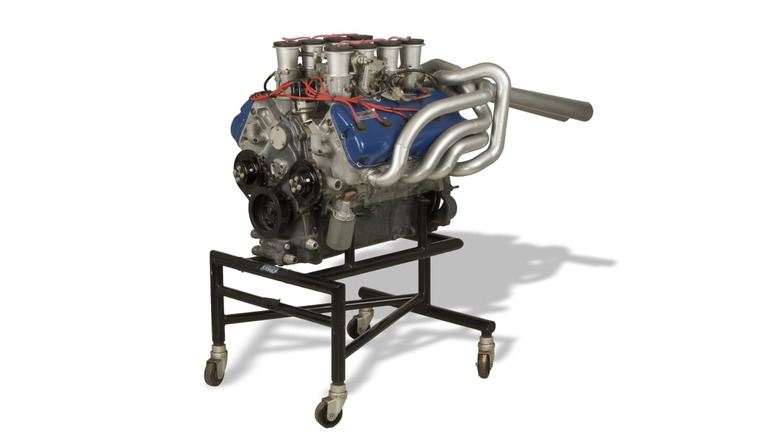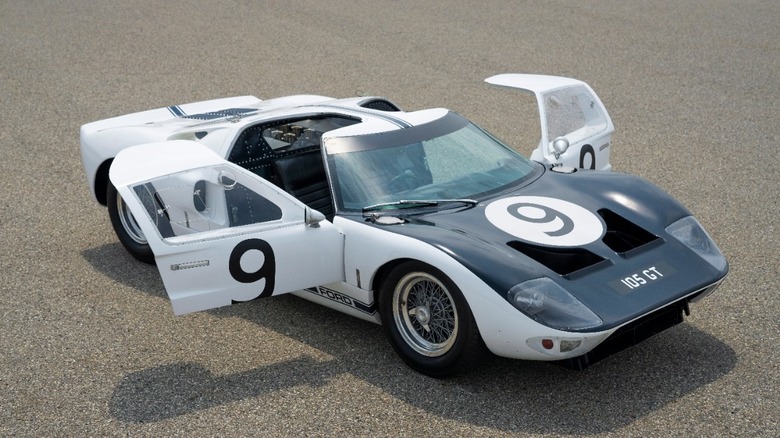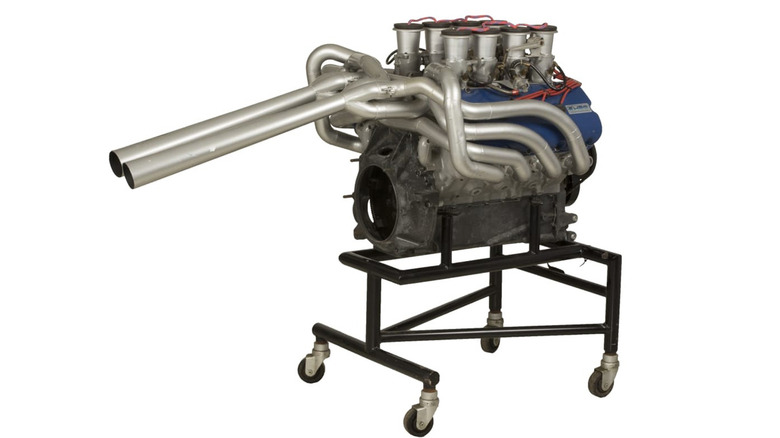Ford's Weird V8 That Was Banned At Le Mans: The Calliope
A calliope, despite sounding like an Italian ice cream, is a musical device that forces steam through a series of whistles, typically protruding from the top of the instrument. What would such an instrument have to do with a Ford V8, though? Well, Ford developed a 427-CI V8, known as the Calliope, for the 1968 Le Mans 24-hour race. The "Calliope" nickname was coined because the fuel injector stacks that sat above each cylinder looked like the whistles on a musical calliope. Unfortunately, the engine never got to prove its worth because the International Sporting Commission (CSI) — the forerunner to the FIA – changed the regulations for 1968, restricting Group 4 cars to 305-CI engines. This is a shame because, as far as the Calliope goes, looking like an archaic musical instrument was just the start of the weirdness.
It was a big-block, three-valve, head-gasketless, all-aluminum V8 that aimed to keep Ford on top in the then-ongoing Ford vs. Ferrari rivalry. This engine was intended to be Ford's killer move and was due to run in 1968. Unfortunately, the rule change meant that it didn't happen, and Ford ultimately ended its official involvement in Le Mans after 1967. Only three of the engines were ever produced, and the promise of a 630 hp race-winning engine (with the potential for 800 hp) was lost to history. However, to fully understand what drove Ford to develop such an engine, we need to take a quick history lesson. We also take a look into the future and the project that could resurrect the engine.
Why Ford developed the Calliope
During the sixties, Ford and Ferrari — two of the world's automotive giants — locked horns in a titanic struggle to gain supremacy in the ultra-competitive 24-hour Le Mans race. Both Ford and Ferrari threw huge resources at it in an attempt to win the prize. The intensity of the battle was so dramatic that a movie based on the two firms' rivalry — titled "Ford v Ferrari" — was released in 2019.
After a deal to buy Ferrari in the early '60s broke down, Henry Ford II made it his mission to beat the Italians at Le Mans and break their stranglehold on the race. The result was the legendary GT40 program, which, after several attempts, culminated in a historic 1-2-3 finish at Le Mans in 1966. But even as Ford celebrated its victories, Ferrari was regrouping, and the competition showed no signs of slowing down.
With Le Mans regulations constantly evolving, Ford engineers decided they needed to think outside of the box. The Calliope was born from this pressure and this thinking, along with many of the cool features of the Ford GT40. The tragedy for engine lovers is that Le Mans officials implemented a 305-CI displacement limit for 1968 as a safety move intended to reduce the high speeds that big-block cars were hitting. This stopped Ford from running the Calliope at Le Mans, and it was relegated from being a potential race winner to a historical curiosity.
The weirdness that might have been
With only three engines ever made and only one making it into a test vehicle, we may never know how successful the engine would have been in the heat of battle. However, we can say that Ford wasn't afraid of experimentation when it came to the Calliope. Beyond its musical links, the engine also featured a three-valve per-cylinder configuration. This comprised two intake valves and one exhaust valve. Another quirk was the fuel delivery injectors; these were integrated into the cylinder heads, replacing the usually required intake manifold. Staying in the same area, Ford designed the engine to use copper rings to seal the bores instead of head gaskets to improve reliability — useful when cars are expected to run for 24 hours. Finally, the engine used an innovative twin-camshaft design, one each for the intake and exhaust valves.
The story of Ford's Calliope V8 is undoubtedly an interesting one — but like all good stories, it has a twist that elevates it above merely interesting. And, incredibly, the Calliope may not have played its last note. Ford enthusiast Dan Schoneck, in collaboration with Jay Brown of FE Power Products, has obtained the castings for the engine and is working to resurrect the Calliope. It may not have made it onto our list of the greatest Ford V8 engines, but Ford's Calliope may yet bring its tune back to life.


